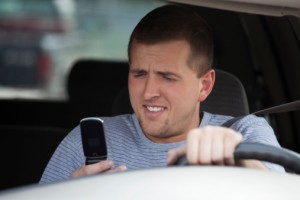 There was a time when the majority of people turned a blind eye to intoxicated drivers and when it was more socially acceptable to drink and drive. Drunk driving laws were not always so well accepted, and people who chose to drive after drinking were often given a sort of free pass. Now, times have changed. A recent editorial in the NY Times says we are at the same point with distracted and reckless driving and that people need to recognize that distracted drivers are responsible for the harm they cause, even if it was unintentional. Is it time to penalize distracted drivers in the same way we do those who cause accidents while drunk?
There was a time when the majority of people turned a blind eye to intoxicated drivers and when it was more socially acceptable to drink and drive. Drunk driving laws were not always so well accepted, and people who chose to drive after drinking were often given a sort of free pass. Now, times have changed. A recent editorial in the NY Times says we are at the same point with distracted and reckless driving and that people need to recognize that distracted drivers are responsible for the harm they cause, even if it was unintentional. Is it time to penalize distracted drivers in the same way we do those who cause accidents while drunk?
In the first 12 days of 2014, seven pedestrians were killed in New York City. In the last five years, taxi accidents have killed 21 pedestrians and bicyclists. Yet only one of those taxi drivers faced criminal charges. Dr. Barron H. Lerner argues that it’s the lack of consequences for drivers like this that allows these accidents to keep happening.
It’s true that Dr. Lerner has a personal connection to the cause—his nephew was killed by a taxi driver as he crossed the street with his father on a rainy night last month. The 9-year-old boy and his father crossed at the intersection and with a “walk” sign. The cause of the accident is still unknown.
Dr. Lerner compares distracted driving now to drunk driving before 1980. He says it’s not adequately addressed in the law books, it’s poorly investigated by police, and rarely results in any criminal charges from the district attorney’s office. In the 1970s, many people were indifferent to tougher drunk driving regulations.
Support for tougher penalties for drunk driving laws and better enforcement came in the 1980s with the help of groups like Mothers Against Drunk Driving (MADD) and Remove Intoxicated Drivers (RID). States passed more than 700 drunk driving laws between 1980 and 1985, lowering the threshold for drunk driving and stiffening the penalties for convictions. Change happened, but it took public outrage and activism.
Now, we see similar poor investigations and a lack of concern when it comes to reckless driving and distractions—particularly in New York City and other large metropolitan areas.
The Scope of Reckless Driving
Reckless driving is defined differently from state to state. Generally, it’s driving behavior executed with little regard to the dangers it poses. This could include speeding, distraction, aggressive driving, and more. It’s because of this lack of a standard definition that statistics are difficult to come by.
Fatal car accidents in New York City in 2012 overwhelmingly involved speeding, disregard for traffic signals, driver inattention and/or alcohol, according to the NYC Department of Transportation. The frequency of distracted driving accidents is likely underreported because drivers often do not admit that they were distracted before an accident.
The word accident implies that the crash wasn’t preventable. Rarely is this the case. More often, someone was distracted, frustrated, or simply disregarded traffic safety so they could get to their destination more quickly. Like drunk driving, reckless driving and distracted driving are types of preventable driving errors that people should be held accountable for when they cause accidents and injuries. People who are injured or lose family members through the actions of another driver should understand their legal options for holding the driver accountable.
